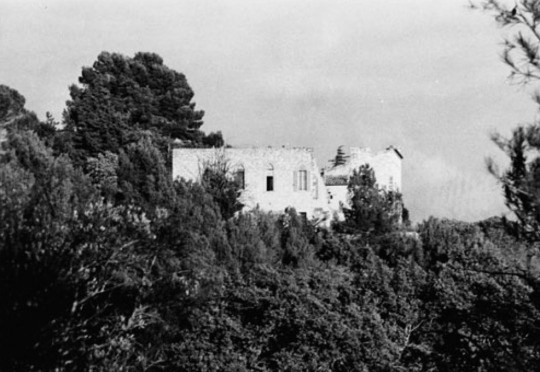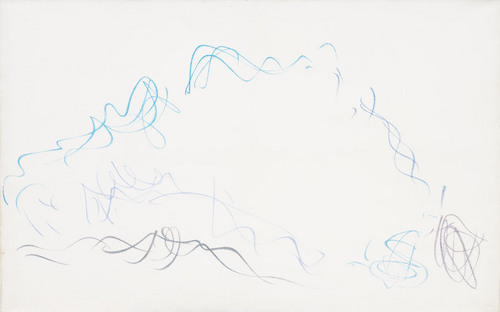Photo

By William Weyman
0 notes
Photo

By Mary Hamilton
0 notes
Text
A Painter in the Centre of Cezanne Research
“In addition to the possibilities these documents offer for a historiographic study of the development of early research in modern art, Marchutz’ work can also be seen as an example for the often underestimated reciprocal influences between creative practice and art historic research.” – Agnes Blaha
Recently, a Agnes Blaha at the University of Vienna wrote a scholarly essay on Marchutz’s contribution to our understanding of Cézanne’s oeuvre titled Leo Marchutz: A Painter in the Centre of Early Cezanne Research. In her introduction, she recounts how Marchutz’s lifetime relationship with the work of Cézanne, both as an artist and an art historian:
“Léo Marchutz, born 1903 in Nuremberg, began his artistic career as an autodidact. In his early years, Cézanne’s art which Marchutz got to know by an exhibition held at the gallery of Bruno Cassierer in Berlin in 1921 and through his visits at the Neue Pinakothek in Munich influenced his view of the possibilities and purposes of art. In his later autobiographical statements, Marchutz’ stressed the importance of his early contacts to Cézanne’s art for his rejection of academic training as an artist and his decision to develop his own style through the individual study of other artists’ works in museums (Châtelet 19). Inspite of this early fascination for Cézanne, it was rather through coincidences that Marchutz began his investigation of Cézanne’s motives, a work which he should continue throughout his whole life. Marchutz first came to Aix-en-Provence in 1928, when his later wife, Anna Kraus, offered him this journey for his help with selling a picture by Cézanne. When they decided to visit the Château Noir, they made the acquaintance of a coachman who had been working for Cézanne and therefore knew some of Cézanne’s favorite places where he regularly went to paint. It seems plausible that this coachman gave the decisive impulse to look out for these places. Arrived at the Château Noir, Marchutz spontaneously decided to rent a small apartment in Cézanne’s old residence, a decision which clearly hints at the enthusiasm he felt for his self-chosen artistic role model. This enthusiasm can also be discerned in Marchutz’ paintings from the first years he spent in Aix, where he definitively settled down in 1931. His landscape paintings with views of the Montagne Sainte-Victoire and a number of still lives painted between 1928 and 1931 show, in spite of all existing differences in style, a deliberate proximity to Cézanne, which already can be seen in the choice of subjects typically associated with Cézanne. Additionally, his interpretation shows the intention to imitate some formal characteristics, especially concerning the creation of volume through large colored patches, an intention that becomes even more obvious when these pictures are compared with his paintings of the Mount Sainte-Victoire from the 1960s, which are in all aspects much more typical for the personal style he had developed.”
#leo marchutz#marchutz#marchutz school#painter in the center of cezanne research#art history#cezanne#painting#aix en provence
0 notes
Photo



"I owe him my fervor for Cezanne"- John Rewald of Leo Marchutz
In light of the Marchutz School's recent excursion to some of Cezanne's most famous working sites in and around Aix, check out these photos on the Marchutz School blog taken by Marchutz and art historian John Rewald. As well as being photographic records of Cezanne's motifs, the photos have acted as references to art historians studying the masterworks that Cezanne created from the same motifs.
Above, top: John Rewald on right, Marchutz on left. View of the Chateau Noir pictured below.
#John Rewald#art history#cezanne#photography#national gallery#leo marchutz#chateau noir#motif#painting#fine art#studio art#study abroad
5 notes
·
View notes
Photo

A Leo Marchutz painting from the Manning Hall collection
#iau college#leo marchutz#art education#painting#light#manning hall#aix en provence#cezanne scholar#the gospel of st luke#drawing
0 notes
Photo


Two still-lifes by Samuel Bjorklund.
0 notes
Text
On Painting and on Presence
"Dear Ben,
Interestingly you speak of ‘meditation’, and being present. This is a practice that has been a part of my life for many years. Slowly I think they are beginning to blend into a state that is mine and guides my work, my working sessions. I have pretty much given up taking on projects, tasks or challenges. Rather I am finding that if I can create the open space, the subject will find me, and more often than not, the ‘how to’. It is very much a process of letting go. I look back and look at all the things I had to ‘fight’ with, and realize that the only real moments of success had little to do with me. Moments of grace where somehow I was not in the way of things happening.
I also remember a statement I found in the chicken coops of Leo’s house at Chateau Noir written by an architect friend of his. The thrust was that Leo should have no concern with the finished product, with the end. That his only job was to stay present and devote himself to the good of the work at hand, the process. This was something with which I struggled for many years, always hoping for results that could justify the hard work and to a certain degree suffering that went into the whole task. In other words, what could satisfy my poor insatiable ego.
That was a lot of years ago, and I still find it the principal concern. I do believe I have made progress, but then I am not sure about anything at this point, because whenever my mind creeps in I have learned that I must distrust it, not believe a word it says.
What you write about time, and what you are after in the moment of work, takes me to lines in the Four Quartets about how evasive time is, how the present contains the past and the future. I have had moments in my work, or rather periods or phases of my work, where I seemed to be floating in a space that contained no time. At those moments there seems not to be room for error, because I don’t seem to be doing much, just standing there recording something, some correlation between the colors on my palette, what is in front of my eyes, and the canvas or paper. I was able to find that most readily in the watercolors of many years ago. And more recently in oils where I sink into a work and a state of working where I really don’t seem to be part of it, just sure that something in me knows exactly what to do from one stroke to the next."
- Samuel Bjorklund
Read the rest of the letter here.
0 notes
Photo

A Leo Marchutz painting from the IAU Manning Hall collection
#leo marchutz#painting#art#iau#manning hall#aix en provence#france#light#color#lithography#art education#cezanne scholar
0 notes
Photo

San Giorgio, Vue de Giudecca by Alan Roberts, Manning Hall collection
2 notes
·
View notes
Photo

a painting by Francois de Asis at Manning Hall
0 notes
Photo



A Leo Marchutz painting and lithographs from the Manning Hall collection at the Institute for American Universities in Aix-en-Provence, France
#aix en provence#leo marchutz#marchutz school#painting#lithography#drawing#art#light#20thcenturymaster
6 notes
·
View notes
Photo

by Leo Marchutz
0 notes
Text
« In the last two decades it has become almost an obsession with art-critics and art-historians – the present writer not completely excluded – to measure the quality of an artist by his attachment to realism on the one hand or his inclination towards non-objective art on the other. However, not ony should Op and Pop have taught us the irrelevance of such an attitude but even more so the age-old fact that “quality” is neither a matter of period nor style but a matter of rank. There are bad Egyptian sculptures and good abstact paintings.
Léo Marchutz being neither abstract or realistic but both and, moreover, good has, so far, found a limited if enthusiastic audience. It is, therefore, most welcome that his friends in Memphis, Tennessee, have made such an admirable effort to create a public for his work by showing his religious panels in a church, in addition to the two other exhibitions with drawings and lithographs elsewhere.
Recollecting my first encounter with Léo more than 10 years ago I am reminded of an unforgettable experience. He had succeeded in talking the Municipality of Aix-en-Provence into arranging a Cézanne Exhibition which, as it turned out, included some paintings from the New Pinakothek in Munich where I was Chief Curator at the time. Since the straircases in the Pavillon Vendôme were all much too narrow we had to unpack the crates in front of the palace in the open. It was a breathtaking moment when Cézanne’z famous La Tranchée was taken out of its case and exposed to the very same light in which it was painted in 1869. The workmen even stopped for a while in numb admiration. It was a revelation – like experiencing the Greek light for the first time….
It must have been this very special quality of light in Provence, I think, rather than a commemorative sentiment that made Léo Marchutz want to live in Cézanne’s country. As a matter of fact, it is LIGHT as a volume and space creating factor and it is LIGHT in its luminosity and spirituality that, in my view, is at the heart of Marchutz’s achievement as an artist.
Hans-Konrad Roethel
The Institute for Advanced Study
Princeton, N.J.
March, 1969.
0 notes
Photo

by Leo Marchutz
0 notes
Photo

By Michele Henot
#Michelehenot#art#paitning#oil painting#life#bright#wow#right#color#drawing#art education#marchutz school#aix en provence#france#tree#fall#autumn#le tholonet#beautiful#whole
0 notes
Photo

by Leo Marchutz (ca. 1960s)
0 notes
